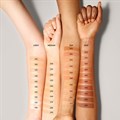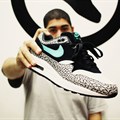
Subscribe & Follow
#ATFexpo2018: How to localise global trends for the SA consumer - Part 2

Personalisation, customisation, and creolisation
Given the world’s current state, an emerging trend is personalisation, customisation, and creolisation. The consumer has a desire for identity and individualism. Cooper says that “once you start tapping into that individualism and start creating something that is completely unique, creolise or personalise, there’s a great opportunity for business.”
Research conducted by Deloitte indicated that one in four consumers are willing to pay more for a personalised product or service. Furthermore, Walpole members say that the most effective trends will be exclusive collaborations with relevant partners (78%), secret and exclusive brand experiences (59%), and personalised online experiences (53%).
Adidas’ customised Mi Adidas range allows customers to start with a blank sneaker canvas and then add the elements of the sneakers themselves. Ikea’s VR app allows users to drop virtual furniture into their homes and view it through their camera for them to realistically and visually see how it might look in their home.

Locally, the Cape Town-based fashion brand Jota-Kena specialises bespoke in denimwear. Similarly, the personalised Drostdy-Hof 3l box as well as Netflorist’s customisable gift offering, and Tshepo the JeanMaker is also a huge influence in this space locally.
You don’t necessarily need to offer something completely unique, but Cooper advises that you should at least offer the opportunity to change those finishes for themselves.
Hypersampling
Another aspect of this trend, especially for the South African consumer, is hypersampling. In her article, ‘Hypersampling black masculinities, Jozi style’, Leora Farber defines hypersampling as the remixing, re-appropriating, re-integrating, fusing, conjoining, interfacing and mashing-up of often disparate elements gleaned from a multiplicity of online and offline sources to produce new fashion-styles.
Cooper notes that township youth, in particular, are interested in thrifting. They purchase pieces of fast fashion and high-end fashion and they combine them to create something that is completely unique. She advises that this kind of styling creates the opportunity for the development of the product; this might even mean vintage sales, sourcing vintage items in order to resell.
“If we look at a colour trend, if something comes through on a high-end element or a purchasing power position, we see that it can also come in at a lower-end, which means that you can target consumers at different price points to ensure that you are incorporating the trend across all levels.
That’s something we refer to as the ‘trickle’ theory; it trickles down from the celebrities, gatekeepers, the media, but also equally it starts movements on the streets so people are starting to adopt on the streets, influencers on the street are creating something new and that meets in the middle and it becomes available at every price point and that’s really when a trend starts developing,” says Cooper.

Social media
Social media has made it easier for brands to communicate directly with the consumer. “They’re not someone simply to be spoken at, but spoken to and to converse with. When you’re building a brand and you have social media platforms, you have the opportunity to develop products around your consumer’s needs, sometimes it’s just as simple as asking them what they need,” advises Cooper.
She adds that the degrees of separation between brands and their customers used to be vast, but because of the development of social media and online communication, the conversation between consumer and brand is more personal than ever before.
However, she warns to tread carefully in this space. “Globally consumers are protesting and expressing displeasure with issues in their societies and social groups. We know that Twitter is very close and we know that brands have had to deal with highly controversial confrontation on social media platforms,” says Cooper. If you need an example, just look at the recent fiasco with Dolce & Gabbana in China.
“Most times when we are doing research for Nicola Cooper and Associates for brands, the consumers that we do research around for that brand are just so elated that the brand cares about what they think that they will give us information, sometimes surveys that take 20 minutes and fill in areas that are not necessary and optional, they’ll actually fuel you with that information because you took a moment to ask them what they think” she adds.
Furthermore, she says that Zaid Osman’s Sneaker Exchange is an example of combining the physical and digital realms, by incorporating a social media platform, the idea of personalisation, customisation, and, in the process, engaging directly with your consumers.
Protest as a selling point
The importance of peer to peer and influencer marketing has gained even more traction as a general distrust in authoritative institutions keeps on growing. “There’s a general global trend of distrust and that’s because of Brexit, the Trump administration, as well as what’s happened in our economic landscape; our consumers generally don’t trust our government, so why are they going to trust you as a corporation?” asks Cooper.
She adds that it is crucial for brands, retailers, and businesses are to start rebuilding that trust by being transparent and by being humble and by telling them ‘we don’t know everything, so help us help you’. A prime example of this, Cooper says, is Nike’s Just Do It campaign with former American NFL player Colin Kaepernick.
The brand had aligned its efforts with the aspirations, ethics, and morals of its consumers and it paid off. While, the campaign had, at first, given rise to a boycott from a certain sect of the American population, Nike’s online sales were said to have flourished within days after the campaign was released. In turn, the video was the second most watched on Nike’s Instagram account.
Cooper says that you don’t have to take that kind of strong approach and aligning politically for your brand, but it’s really important to your consumers, especially the younger conscious consumer. In the South African context, Cooper says that Castle Lager’s #BreakTheLabel campaign is an example of how locals brands, similarly to Nike, are starting to articulate without getting political. As they are able to identify the diversity of the consumer and not stereotype them and allow them to be literally ‘more than that’.
We believe in a label-free South Africa. Let’s share a Castle and #SmashTheLabel. pic.twitter.com/uJ1rhqrGpd
— Castle Lager SA (@CastleLagerSA) July 24, 2018
In response to this, consumers are looking to explore their protest through artistic forms in fashion. “The collaboration between art and fashion is also highlighted in this trend with elements of graffiti print and statement protests. This consolidation between art and fashion results in the channelling of disillusionment into sartorial protest. What we’ve seen on the majority of the runways are very bold movements, slogans, confrontational, and loud pieces in order to express individualism,” says Cooper.
She further explains that the bright expressive aesthetic along with the mixing slogans and streetwear highlight and celebrate individuality. The burgeoning DIY movement is also evolving with more and more consumers wanting to write and paint on their clothes. Sports elements are also included in this but, she cautions, that it must remain contemporary and in line with trends like action pleats, elbow grease.
"The collaboration between art and fashion is also highlighted with elements of graffiti print and statement protests. “This consolidation between art and fashion results in the channelling of disillusionment into a sartorial protest,” she adds.

“Consumers are pushing for an individual voice amongst their peers due to vast areas of mainstreaming in society, the desire to be unique, but also individuality is expressed within this trend by linking art and graffiti styles within their fashion choices. Art is an expression that is adopted in order to create a conversation surrounding certain viewpoints as well as promoting the concept that each individual has their own voice and should have the ability to exhibit this,” she says.
Looking beyond the local consumer
Finally, Cooper says that local brands should consider developing products with international consumers in mind, particularly because the internet makes it easier to access the global consumer.
“Our content has dramatically stretched the horizon of the expectations of Africa’s young people. Our horizons have just expanded and that’s something that I always say to South African brands, designers, and product developers, the minute you go online, you are no longer local, you are international,” says Cooper.
She adds that the unique African footprint is highly desirable abroad as seen with the success of pop culture products like Marvel’s Black Panther.




















